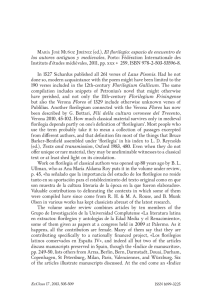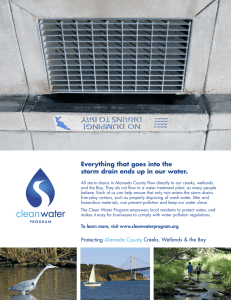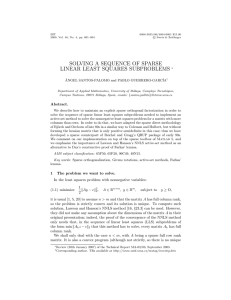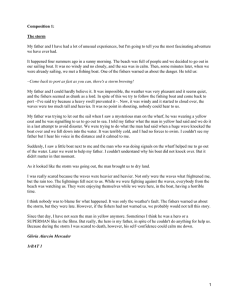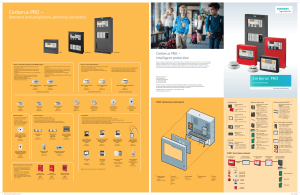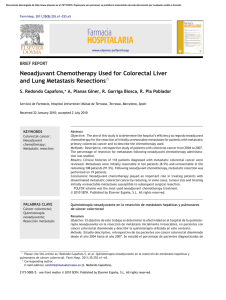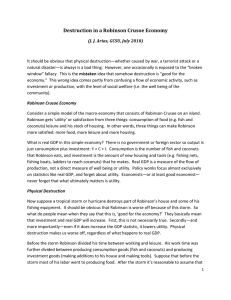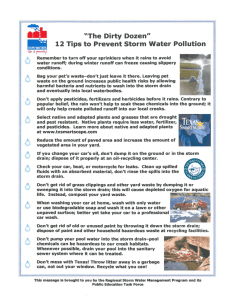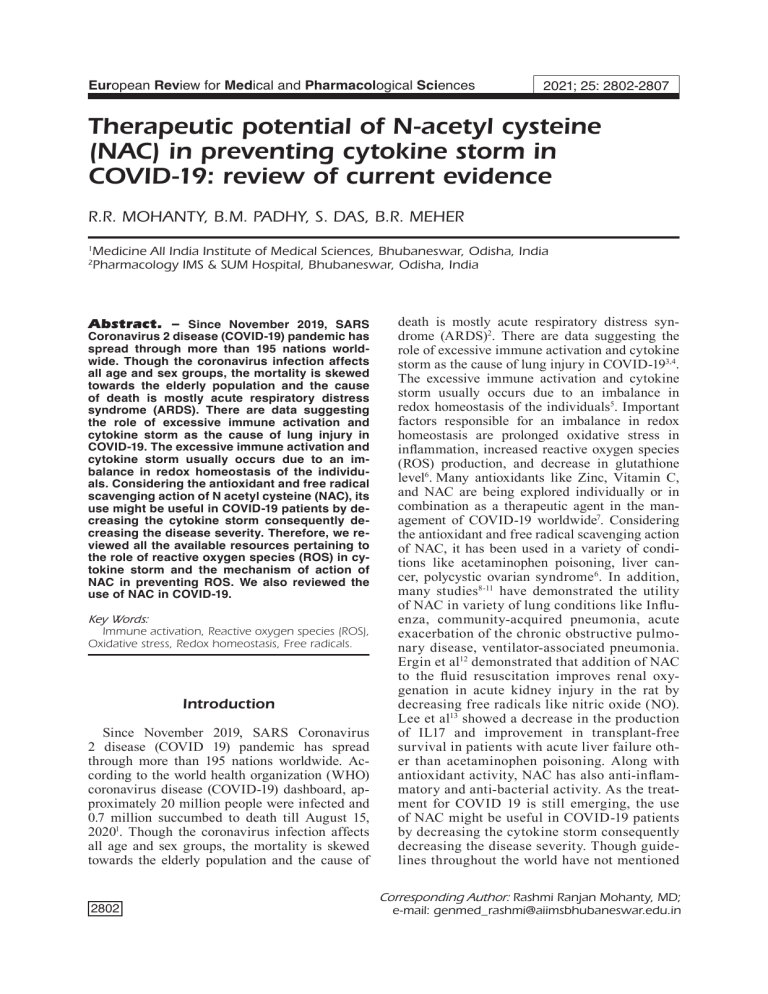
European Review for Medical and Pharmacological Sciences 2021; 25: 2802-2807 Therapeutic potential of N-acetyl cysteine (NAC) in preventing cytokine storm in COVID-19: review of current evidence R.R. MOHANTY, B.M. PADHY, S. DAS, B.R. MEHER Medicine All India Institute of Medical Sciences, Bhubaneswar, Odisha, India Pharmacology IMS & SUM Hospital, Bhubaneswar, Odisha, India 1 2 Abstract. – Since November 2019, SARS Coronavirus 2 disease (COVID-19) pandemic has spread through more than 195 nations worldwide. Though the coronavirus infection affects all age and sex groups, the mortality is skewed towards the elderly population and the cause of death is mostly acute respiratory distress syndrome (ARDS). There are data suggesting the role of excessive immune activation and cytokine storm as the cause of lung injury in COVID-19. The excessive immune activation and cytokine storm usually occurs due to an imbalance in redox homeostasis of the individuals. Considering the antioxidant and free radical scavenging action of N acetyl cysteine (NAC), its use might be useful in COVID-19 patients by decreasing the cytokine storm consequently decreasing the disease severity. Therefore, we reviewed all the available resources pertaining to the role of reactive oxygen species (ROS) in cytokine storm and the mechanism of action of NAC in preventing ROS. We also reviewed the use of NAC in COVID-19. Key Words: Immune activation, Reactive oxygen species (ROS), Oxidative stress, Redox homeostasis, Free radicals. Introduction Since November 2019, SARS Coronavirus 2 disease (COVID 19) pandemic has spread through more than 195 nations worldwide. According to the world health organization (WHO) coronavirus disease (COVID-19) dashboard, approximately 20 million people were infected and 0.7 million succumbed to death till August 15, 20201. Though the coronavirus infection affects all age and sex groups, the mortality is skewed towards the elderly population and the cause of 2802 death is mostly acute respiratory distress syndrome (ARDS)2. There are data suggesting the role of excessive immune activation and cytokine storm as the cause of lung injury in COVID-193,4. The excessive immune activation and cytokine storm usually occurs due to an imbalance in redox homeostasis of the individuals5. Important factors responsible for an imbalance in redox homeostasis are prolonged oxidative stress in inflammation, increased reactive oxygen species (ROS) production, and decrease in glutathione level6. Many antioxidants like Zinc, Vitamin C, and NAC are being explored individually or in combination as a therapeutic agent in the management of COVID-19 worldwide7. Considering the antioxidant and free radical scavenging action of NAC, it has been used in a variety of conditions like acetaminophen poisoning, liver cancer, polycystic ovarian syndrome 6. In addition, many studies8-11 have demonstrated the utility of NAC in variety of lung conditions like Influenza, community-acquired pneumonia, acute exacerbation of the chronic obstructive pulmonary disease, ventilator-associated pneumonia. Ergin et al12 demonstrated that addition of NAC to the fluid resuscitation improves renal oxygenation in acute kidney injury in the rat by decreasing free radicals like nitric oxide (NO). Lee et al13 showed a decrease in the production of IL17 and improvement in transplant-free survival in patients with acute liver failure other than acetaminophen poisoning. Along with antioxidant activity, NAC has also anti-inflammatory and anti-bacterial activity. As the treatment for COVID 19 is still emerging, the use of NAC might be useful in COVID-19 patients by decreasing the cytokine storm consequently decreasing the disease severity. Though guidelines throughout the world have not mentioned Corresponding Author: Rashmi Ranjan Mohanty, MD; e-mail: [email protected] Therapeutic potential of NAC in preventing cytokine storm in COVID-19 NAC as a treatment option in COVID-19, it is being used as an off-label treatment at many centers14. Therefore, we searched all the available resources in PubMed, Cochrane library on the use of NAC to review two key objectives, i.e.,: Therapeutic potential of NAC in decreasing the immune activation and cytokine storm. Efficacy of NAC in management of COVID-19. We also reviewed all the studies registered in clinical trial.gov on the use of NAC in COVID 19. Reactive Oxygen Species Induced Cytokine Storm Excessive production of ROS due to oxidative stress and decreased antioxidant level plays a central role in the development of cytokine storm during infections2,15. Many predisposing factors like diabetes, inflammaging, decrease glutathione level with aging triggers ROS production, and results in cytokine storm due to increased oxidative stress2. ROS causes cell death by apoptosis and increases the release of pro-inflammatory cytokines like IL-2, IL-6, and TNF-α by activated macrophages15. The rise of IL-2 and IL-6 has been well documented in COVID-19 in the hyper-inflammatory stage of the disease. There is a decrease in CD4, CD8 lymphocytes and increase neutrophil to lymphocyte ratio (NLR) in severe COVID 19 along with a rise in monocyte macrophages leading to a rise in pro-inflammatory cytokines IL-6, IL-23. This hyper-inflammatory immune response leads to the production of ROS by epithelial cells. ROS stimulates the synthesis of (NOD)-like receptor protein 3 inflammasome; (NLRP3) and nuclear factor kappa-light-chainenhancer of activated B cell (NF-κB) which propagates the cytokine production4. These pro-inflammatory cytokines increase the release of nitric oxide (NO) which causes vasodilatation, hypotension, vascular leakage, and organ damage. Thus, in the latter part of COVID-19, these cytokines and free radicals play a major role in disease pathogenesis rather than the virus itself. NAC As an Antioxidant N-acetyl cysteine (NAC) is a safe and inexpensive medication commercially available since 1960. It is the N-acetyl derivative of the natural amino acid L-cysteine and has been used in a variety of conditions including lung diseases6. However, only USFDA approved indication of NAC is as an antidote for paracetamol poisoning. Many studies8,16 in humans have demon- strated the antioxidant property of NAC. The antioxidant property of NAC can be attributed to three mechanisms a) direct antioxidant activity b) indirect antioxidant activity, and c) disulfide bond-breaking activity17. The direct antioxidant activity of NAC against reactive oxygen species like H2O2, ONOOH, O2­, HO, HO(X), and NO2 due to the presence of thiol group in it has been established in both in vitro and in vivo studies18-23. NAC has highest antioxidant activity towards NO2 and HO(X) in vivo17. It exhibits indirect antioxidant activity by increasing the glutathione level at the site of inflammation 24,25. Meyer et al26 demonstrated that NAC increased the level of glutathione to almost normal levels in lung fluid in patients with pulmonary fibrosis. NAC also exerts mucolytic activity in the lungs in inflammatory conditions by its disulfide bond-breaking action17. The breakdown products increase free thiol which exhibits antioxidant action by directly inhibiting the reactive oxygen species (ROS) and indirectly by increasing the glutathione level. The pathogenesis of the cytokine storm and the action of NAC has been depicted in Figure 1. Therapeutic Potential of NAC in Decreasing the Immune Activation and Cytokine Storm N-acetyl cysteine has been used as an antioxidant in clinical practice for decades, but its uses are mostly off-label. However, there is ample evidence in preclinical and clinical studies that it can attenuate immune activation and prevent cytokine release. Davreux et al27 demonstrated that lipopolysaccharide-induced increased lung permeability and lung injury is significantly attenuated by NAC in a rat model. In the same study, although NAC did not affect the migration of neutrophils to the site of injury, it significantly decreased the activation and cytokine production by neutrophils. In another study by Ungheri et al28, NAC significantly decreased the mortality in influenza affected mice by decreasing the production of ROS and cytokines like TNF and IL-6. Similarly, Ergin et al12 and Garozzo et al29 demonstrated the beneficial effect of NAC in influenza and acute kidney injury in the rat model. Animal studies showing the antioxidant effect of NAC in inflammation depicted in Table I. From the above studies, it is evident that NAC has therapeutic potential in decreasing the immune activation and resultant cytokine storm. 2803 R.R. Mohanty, B.M. Padhy, S. Das, B.R. Meher Figure 1. The pathogenesis of the cytokine storm and the action of NAC (COVID-19 causes increased ROS production and immune activation which in turn leads to cytokine storm in the hyper-inflammatory stage of the disease. Oxidative stress and low glutathione level predispose to the condition: NAC has a potential role in down regulating the cascade of the event by direct and indirect antioxidant activity). The clinical utility of NAC in various diseases has been proved by many studies8-11. Study characteristics and its outcome of NAC use in different lung diseases in humans are depicted in Table II. The addition of NAC to the standard treatment protocol decreases the severity of many acute respiratory conditions like influenza, community-acquired pneumonia (CAP), ARDS, ventilator-associated pneumonia (VAP) mostly by atten- Table I. Animal studies showing the antioxidant effect of NAC. Study Study hypothesis Davreux et al27 1997 Observation Mechanism of action NAC might attenuate lung injury following an intratracheal challenge with endotoxin (lipopolysaccharide; LPS) Significant decrease in lung permeability due to lipopolysaccharide (LPS) induced lung injury in mice (p < 0.5) Decrease neutrophil activation in NAC group. Scavenging of free radicals and decrease in the neutrophil oxidative burst Ungheri et al28 2000 NAC may decrease the level of ROS in mice infected intranasally by influenza virus Administration of NAC in influenza infected mice decreases mortality significantly Decreasing ROS (XO, TNF, IL-6) Garozzo et al29 2007 Addition of NAC to Combining NAC with oseltamivir decreases the oseltamivir increases the oxidative stress in viral survival of mice infection in murine model Improvement in microcirculatory oxygenation in kidney may occur due to addition of NAC along with fluid resuscitation by reduction of oxidative stress. Ergin et al12 2016 2804 NAC supplementation in resuscitation fluids improved renal microcirculatory oxygenation, inflammation, and function in a rat model of endotoxemia Antioxidant effect against oxidative stress associated with viral infection Dampening the accumulation of NO in kidney tissue (p < 0.01) Therapeutic potential of NAC in preventing cytokine storm in COVID-19 Table II. Use of NAC in different lung diseases in human. Study Title Study design Observation Flora et al9 1997 “Attenuation of influenza-like Randomized control trial symptomatology and improvement of cell-mediated immunity with long-term N-acetylcysteine treatment” NAC treatment decreased the severity of infection and increased cell mediated immunity. Zhang et al8 2018 “N-acetyl cysteine improves Randomized control trial oxidative stress and inflammatory response in patients with community acquired pneumonia” Significant decrease in TNF-α (p < 0.0010) in NAC group along with increase in total antioxidant capacity. Zhang et al10 2017 Effects of N-acetylcysteine Meta-analysis treatment in acute respiratory distress syndrome: a meta-analysis NAC group had less duration of intensive care unit stay. Sharafkhah et al11 2018 “Safety and efficacy of Randomized control trial N-acetyl-cysteine for prophylaxis of ventilator-associated pneumonia: a randomized, double blind, placebo-controlled clinical trial” uating the immune activation. In all the studies, the daily dose of NAC, 1200 mg, was well tolerated without any significant adverse reaction. Though there is limited direct evidence, it can be inferred from these studies that the clinical efficacy of NAC is possibly due to the composite effect of its antioxidant and immunomodulatory activities. Efficacy of NAC in Management of COVID-19 As the role of ROS and cytokine storm in the pathogenesis of COVID-19 became more evident, many hypotheses argued in favor of N-acetyl cysteine use in COVID 1915,30,31. Nasi et al5 suggested evaluation of NAC as a cost-effective therapeutic measure in COVID-19 for protection against excessive ROS production. Further, Andreou et al30 hypothesized that the combination of remdesivir, copper, NAC, NO, and colchicine could be an effective treatment option for COVID-19. Till the end of July 2020, robust published data regarding the indication, dosing, safety, and efficacy of NAC in COVID-19 was lacking. We found only 2 case series related to the use of NAC in COVID-1932,33. The details of the studies are depicted in Table III. In both the case series, all patients improved. Ibrahim et al33 documented that there is a decrease in serum CRP and ferritin levels in all Incidence of less severe disease and complete recovery was significantly higher in NAC treated group. The suggested mechanism for improvement is due to antioxidant an mucolytic action of NAC. patients after NAC therapy indicating the possibility of a reduction in oxidative stress. There was a significant improvement in liver function and oxygen requirement in all patients after the addition of NAC. Nine patients requiring ECMO were improved and discontinued from ECMO after initiation of NAC. Though the outcome is encouraging, it is difficult to predict the efficacy of NAC in COVID-19 as the sample size is extremely small, and also all the patients were receiving multiple combinations of therapies. Presently there are seven ongoing clinical trials evaluating the dose, safety, and efficacy of NAC therapy in COVID-19. The outcome measures in different clinical trials range from clinical improvement, safety and tolerability, change in lung function to change in inflammatory cytokines. The results of these trials in the near future shall clarify the utility of this agent in COVID-19. Conclusions Shortly, NAC has proven antioxidant activity which is useful in attenuating the immune activation and cytokine storm in animal and human studies. It is a safe, cost-effective, widely available drug, and its mechanism of action hypothetically suggests its potential role in the manage2805 R.R. Mohanty, B.M. Padhy, S. Das, B.R. Meher Table III. Result for NAC use in COVID-19. Study Type of study Study population Outcome Horowitz et al32 Case report Case 1 2020 2 cases 53-year male, left lower lobe pneumonia, COVID 19 antibody positive. NAC 600 mg twice daily orally with other standard treatment Case 2: 48-year-old female, left lobar atypical pneumonia, clinically suspected COVID 19 NAC 1200 mg daily with other standard treatment Both cases improved Ibrahim et al33 Case series Male: 9, Female: 1 2020 10 cases Severe COVID 19, all patients are on ECMO. Treatment: NAC with other standard mode of treatment. NAC dose: 600 mg twice daily, intravenous 8 patients discharged home, 2 patients improved. Mean change in CRP from 160 ± 97 to 31 ± 24 Mean change in ferritin from 3630 ± 252 to 1543 ± 762 ment of cytokine storm in COVID-19. However, with the limited evidence currently available, it would be imprudent to formulate any recommendation regarding the use of NAC in COVID-19. Any future recommendation regarding its use in this condition will depend on the outcome of the ongoing clinical trials. Conflict of Interest The Authors declare that they have no conflict of interests. References 1) WHO Coronavirus Disease (COVID-19) Dashboard. Available at: https://covid19.who.int/ 1. 2) Meftahi GH, Jangravi Z, Sahraei H, Bahari Z. The possible pathophysiology mechanism of cytokine storm in elderly adults with COVID-19 infection: the contribution of “inflame-aging”. Inflamm Res 2020; 69: 825-839. 3) Soy M, Keser G, Atagündüz P, Tabak F, Atagündüz I, Kayhan S. Cytokine storm in COVID-19: pathogenesis and overview of anti-inflammatory agents used in treatment. Clin Rheumatol 2020; 39: 2085-2094. 4) Bhaskar S, Sinha A, Banach M, Mittoo S, Weissert R, Kass JS, Rajagopal S, Pai AR, Kutty S. Cytokine storm in COVID-19–Immunopathological mechanisms, clinical considerations, and therapeutic approaches: the REPROGRAM Consortium Position Paper. Front Immunol 2020; 11:1648. 5) Nasi A, McArdle S, Gaudernack G, Westman G, Melief C, Rockberg J, Arens R, Kouretas D, Sjölin J, Mangsbo S. Reactive oxygen species as an ini- 2806 6) 7) 8) 9) 10) 11) 12) tiator of toxic innate immune responses in retort to SARS-CoV-2 in an ageing population, consider N-acetylcysteine as early therapeutic intervention. Toxicol Rep 2020; 7: 768-771. Mokhtari V, Afsharian P, Shahhoseini M, Kalantar SM, Moini A. A review on various uses of n-acetyl cysteine. Cell J 2017; 19: 11-17. Zabetakis I, Lordan R, Norton C, Tsoupras A. COVID-19: the inflammation link and the role of nutrition in potential mitigation. Nutrients 2020; 12: 1466. Zhang Q, Ju Y, Ma Y, Wang T. N-acetylcysteine improves oxidative stress and inflammatory response in patients with community acquired pneumonia: a randomized controlled trial. Medicine (Baltimore) 2018; 97: e13087. De Flora S, Grassi C, Carati L. Attenuation of influenza-like symptomatology and improvement of cell-mediated immunity with long-term N-acetylcysteine treatment. Eur Respir J 1997; 10: 15351541. Black PN, Morgan-Day A, McMillan TE, Poole PJ, Young RP. Randomised, controlled trial of N-acetylcysteine for treatment of acute exacerbations of chronic obstructive pulmonary disease [ISRCTN21676344]. BMC Pulm Med 2004; 4:13. Sharafkhah M, Abdolrazaghnejad A, Zarinfar N, Mohammadbeigi A, Massoudifar A, Abaszadeh S. Safety and efficacy of N-acetyl-cysteine for prophylaxis of ventilator-associated pneumonia: a randomized, double blind, placebo-controlled clinical trial. Med Gas Res 2018; 8: 19-23. Ergin B, Guerci P, Zafrani L, Nocken F, Kandil A, Gurel-Gurevin E, Demirci-Tansel C, Ince C. Effects of N-acetylcysteine (NAC) supplementation in resuscitation fluids on renal microcirculatory oxygenation, inflammation, and function in a rat model of endotoxemia. Intensive Care Med Exp 2016; 4: 29. Therapeutic potential of NAC in preventing cytokine storm in COVID-19 13) Lee WM, Hynan LS, Rossaro L, Fontana RJ, Stravitz RT, Larson AM, Davern II TL, Murray NG, McCashland T, Reisch JS, Robuck PR; the Acute Liver Failure Study Group. Intravenous N-acetylcysteine improves transplant-free survival in early-stage non-acetaminophen acute liver failure Gastroenterology 2009; 137: 856-864.e1. 14) Schönrich G, Raftery MJ, Samstag Y. Devilishly radical NETwork in COVID-19: oxidative stress, neutrophil extracellular traps (NETs), and T cell suppression. Adv Biol Regul 2020; 77: 100741. 15) Wu J. Tackle the free radicals damage in COVID-19. Nitric Oxide 2020; 102: 39-41. 16) Eakin K, Baratz-Goldstein R, Pick CG, Zindel O, Balaban CD, Hoffer ME, Lockwood M, Miller J, Hoffer BJ. Efficacy of N-acetyl cysteine in traumatic brain injury. PLoS One 2014: 9; e90617. 17) Aldini G, Altomare A, Baron G, Vistoli G, Carini M, Borsani L, Sergio F.N-Acetylcysteine as an antioxidant and disulphide breaking agent: the reasons why. Free Radic Res 2018; 52: 751-762. 18) Colombo G, Clerici M, Giustarini D, Rossi R, Milzani A, Dalle-Donne I. Redox albuminomics: oxidized albumin in human diseases. Antioxid Redox Signal 2012; 17: 1515-1527. 19) Trujillo M, Radi R. Peroxynitrite reaction with the reduced and the oxidized forms of lipoic acid: new insights into the reaction of peroxynitrite with thiols. Arch Biochem Biophys 2002; 397: 91-98. 20) Aldini G, Regazzoni L, Orioli M, Rimoldi I, Facino RM, Carini M. A tandem MS precursor-ion scan approach to identify variable covalent modification of albumin Cys34: a new tool for studying vascular carbonylation. J Mass Spectrom 2008; 43:1470-1481. 21) Carballal S, Radi R, Kirk MC, Barnes S, Freeman BA, Alvarez B. Sulfenic acid formation in human serum albumin by hydrogen peroxide and peroxynitrite. Biochemistry 2003; 42: 9906-9914. 22) Storkey C, Davies MJ, Pattison DI. Reevaluation of the rate constants for the reaction of hypochlorous acid (HOCl) with cysteine, methionine, and peptide derivatives using a new competition kinetic approach. Free Radic Biol Med 2014; 73: 60-66. 23) Samuni Y, Goldstein S, Dean OM, Berk M. The chemistry and biological activities of N-acetylcysteine. Biochim Biophys Acta 2013; 1830: 41174129. 24) Zhang H, Su W, Ying Z, Chen Y, Zhou L, Li Y, Zhang J, Zhang L, Wang T. N-acetylcysteine attenuates intrauterine growth retardation-induced hepatic damage in suckling piglets by improving glutathione synthesis and cellular homeostasis. Eur J Nutr 2018; 57: 327-338. 25) Ortiz MS, Forti KM, Suárez Martinez EB, Muñoz LG, Husain K, Muñiz WH. Effects of antioxidant N-acetylcysteine against paraquat-induced oxidative stress in vital tissues of mice. Int J Sci Basic Appl Res 2016; 26: 26-46. 26) Meyer A, Buhl R, Kampf S, Magnussen H. Intravenous N-acetylcysteine and lung glutathione of patients with pulmonary fibrosis and normals. Am J Respir Crit Care Med 1995; 152: 1055-1060. 27) Davreux CJ, Soric I, Nathens AB, Watson RW, McGilvray ID, Suntres ZE, Shek PN, Rotstein OD. N-acetyl cysteine attenuates acute lung injury in the rat. Shock 1997; 8: 432-438. 28) Ungheri D, Pisani C, Sanson G, Bertani A, Schioppacassi G, Delgado R, Sironi M, Ghezzi P. Protective effect of n-acetylcysteine in a model of influenza infection in mice. Int J Immunopathol Pharmacol 2000; 13: 123-128. 29) Garozzo A, Tempera G, Ungheri D, Timpanaro R, Castro A. N-acetylcysteine synergizes with oseltamivir in protecting mice from lethal influenza infection. Int J Immunopathol Pharmacol 2007; 20: 349-354. 30) Andreou A, Trantza S, Filippou D, Sipsas N, Tsiodras S. COVID-19: the potential role of copper and N-acetylcysteine (NAC) in a combination of candidate antiviral treatments against SARSCoV-2. In Vivo 2020; 34: 1567-1588. 31) Jorge-Aarón RM, Rosa-Ester MP. N-acetylcysteine as a potential treatment for novel coronavirus disease 2019. Future Microbiol 2020; 10.2217/ fmb-2020-0074. 32) Horowitz RI, Freeman PR, Bruzzese J. Efficacy of glutathione therapy in relieving dyspnea associated with COVID-19 pneumonia: a report of 2 cases. Respir Med Case Rep 2020; 30: 101063. 33) Ibrahim H, Perl A, Smith D, Lewis T, Kon Z, Goldenberg R, Yarta K, Staniloae C, Williams M. Therapeutic blockade of inflammation in severe COVID-19 infection with intravenous N-acetylcysteine. Therapeutic blockade of inflammation in severe COVID-19 infection with intravenous N-acetylcysteine. Clin Immunol 2020; 219: 108544. 2807
